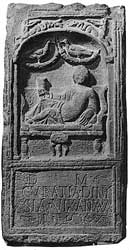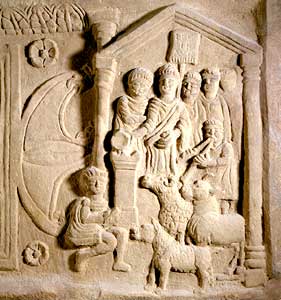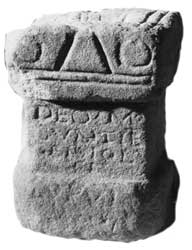
Click on the image for a larger version.
|
Image
details:
Scenes of dining were popular on funerary
reliefs. Diners, both male and Women could also be represented
dining on funerary reliefs. This is the tombstone of Curatia
Dinysia, from Chester
Image ownership:
Copyright. Grosvenor Museum, Chester |
In perhaps the best known tablet from Vindolanda Claudia Severa
invites her friend Sulpicia Lepidina, Cerialis' wife, to her birthday
party (291):
'Claudia Severa to her Lepidina greetings. On 11 September, sister,
for the day of the celebration of my birthday, I give you a warm
invitation to make sure that you come to us, to make the day more
enjoyable for me by your arrival, if you are present (?). Give my
greetings to your Cerialis. My Aelius and my little son send him
(?) their greetings. I shall expect you, sister. Farewell, sister,
my dearest soul, as I hope to prosper, and hail.
Aelius is Aelius Brocchus, whom we meet elsewhere as a friend of
Cerialis, also a prefect. Brocchus is one of the diners recorded
in a long record of poultry and geese consumed at Vindolanda (to
be published in the third volume of Vindolanda tablets), which sometimes
notes who was present on the day in question. The guests included
not only Brocchus and other peers of Cerialis, but also the governor
of the province. It was for such occasions that the dinner dress
and dining gear were perhaps required (see Diet
and dining). Hunting was also one of the shared pleasures of
this officer class. In a letter to Brocchus Cerialis asks him to
send hunting-nets (plagae) (233).
The tablets also refer to dining on venison (191),
although its importance in social life was probably much greater
than its calorific contribution. The enthusiasm for the chase is
well demonstrated in a cavalry officer's bragging rededication of
an altar to Silvanus at Stanhope in Weardale, County Durham :
'Gaius Tetius Veturius Micianus, prefect of the ala Sebosiana,
on fulfilment of his vow willingly set up this for taking a wild
boar of remarkable fineness which many of his predecessors had been
unable to bag'
Social networks were maintained not only through visits but through
correspondence itself. Much effort was expended over the drafting
of letters (225).
This applies especially to those letters written to recommend the
writer, or individuals on whose behalf the writer is acting, couched
in the same terms of friendship and concern for well-being. Thus
the Vindolanda letters shed light on the Roman referencing system
(250).
Letters also sustained friendships between ordinary soldiers, between
current and former 'mess-mates' on different postings. These letters
themselves make reference to other letters, those that had been
sent and those that ought to have been sent (311):
"Sollemnis to Paris his brother, very many greetings. I want
you to know that I am in very good health, as I hope you are in
turn, you neglectful man, who have sent me not even one letter.
But I think that I am behaving in a more considerate fashion in
writing to you ... to you, brother, ... my messmate. Greet from
me Diligens and Cogitatus and Corinthus and I ask that you send
me the names ... Farewell, dearest brother (?).
Religion

Click on the image for a larger version.
|
Image
details:
A relief depicting a sacrifice scene on the
Bridgeness slab (from the Antonine Wall, Scotland). In the
foreground are the victims, a boar, ram and bull, with a servant
and flute player. Behind them the celebrant pours a libation
on the altar.
Image ownership:
© The Trustees of the National Museums of Scotland |
As well as birthdays, religious festivals provided other occasions
for celebration. The tablets include several references to festivals,
including the Saturnalia (301),
celebrated on the shortest day of the year when masters and slaves
swapped roles and slaves enjoyed the master's privileges. There
are other references to a priest and to a shrine (313),
the latter perhaps the temple excavated
in 2001. Feasting and sacrifice probably marked all such occasions:
one tablet refers to marking New Year's Day with a sacrifice (265).

Click on the image for a larger version.
|
Image
details:
An altar to the god Mogons and to the genius
of the place. (deo mogunti et genio loci)
Image ownership:
© Vindolanda Trust |
The altars dedicated in later periods at Vindolanda and other
frontier sites remind us of the wide fellowship of gods which soldiers
brought to Britain's frontier. Among these were the official cults
of Rome, of the emperor, of the city of Rome and of the unit, the
deities of the Greco-Roman pantheon (e.g. Mars, Neptune, Mercury,
and Silvanus) and eastern 'mystery' cults, like the worship of Mithras.
There were also local and regional deities of the northwest provinces
(Cocidius, Mogons, the Mother Goddesses, and the Veteres), some
brought from regimental homelands, others found in Britain.
Tablet database link: Browse all tablets related to social events or religion.
|